Rep. Jared Polis
Att: Nissa Erickson
101 West Main Street Suite 101D
PO Box 1453
Frisco, CO 80443
RE: Tenderfoot Trail Project
Dear Ms. Erickson;
The above referenced Organizations are contacting you to address concerns recently raised with regard to the proposed development of a multiple use single track trail system on Forest Service lands in the vicinity of Tenderfoot Mountain outside Dillon, Colorado. For purposes of these comments, this project will be referred to as “the Proposal”. The Organizations do not believe the specific facts surrounding the Proposal have been fully explained to the public, as only the scoping portion of the Federal planning process has been completed. The Organizations believe once the Proposal and levels of associated planning already performed are completely understood, many of these concerns will be minimized.
Prior to addressing the merits of the Proposal, we believe a brief summary of each Organization is needed. The Colorado Off-Highway Vehicle Coalition (“COHVCO”) is a grassroots advocacy organization of approximately 2,500 members seeking to represent, assist, educate, and empower all OHV recreationists in the protection and promotion of off-highway motorized recreation throughout Colorado. COHVCO is an environmental organization that advocates and promotes the responsible use and conservation of our public lands and natural resources to preserve their aesthetic and recreational qualities for future generations.
The Trail Preservation Alliance (“TPA”) is a 100 percent volunteer organization whose intention is to be a viable partner, working with the United States Forest Service (USFS) and the Bureau of Land Management (BLM) to preserve the sport of trail riding. The TPA acts as an advocate of the sport and takes the necessary action to insure that the USFS and BLM allocate to trail riding a fair and equitable percentage of access to public lands.
The Organizations are aware that often conflict from public usage of public lands can be a concern for those private landowners in the area. Experiences in other areas with this issue have taught the Organizations that developing a minimal impact trail system is key to fostering good relations with all users and avoiding conflict. Our Organizations believe that after a complete review of the Proposal, and related planning documents, you will clearly conclude that current concerns are not based on an accurate understanding of the Proposal and have been avoided in the development of the Proposal.
The Proposal is truly a small project and does not significantly impact the large number and mileage of routes that were to be closed as part of the recent White River Travel Management plan. The Proposal encompasses over 4,000 acres and only adds 15 miles of new single track trails and restricts access on an additional 15 miles of existing routes to uses no wider than 36 inches in width. The Organizations do not believe trail density will be an issue with the Proposal.
The Organizations believe that width restrictors will be a significant implementation tool in the Proposal, as width restrictors are an effective tool in minimizing width expansion issues that could arise from over width vehicles attempting to use the trail network. These 36 inch wide routes would be closed for 8 months out of the year to further minimize any possible impacts in the Proposal area. The entire intent of the Proposal is to address multiple use needs in a manner that does not impact local residents or other users of the Tenderfoot Mountain area.
1. Economics
While the Proposal is a comparatively small project, the significance of the project cannot be overstated to the users of the trail network. Currently these users are not able to obtain a full day single track trail experience in the Summit County area, and are forced to leave the area to obtain this experience. The Proposal will allow monies that are currently spent in other states or counties as a result of the severely limited opportunities to be retained in the Summit County economy. Given previous experiences with our Organizations and Federal Land managers, the Proposal will clearly be an economic benefit to the Summit County economy.
The economic impact to the Colorado Economy of OHV recreation is over $1 billion dollars a year and over $200 million of that occurs in the central Colorado counties. In the central Colorado counties, OHV recreation provides for almost 3,000 year round jobs. The Organizations are not asserting this Proposal will significantly alter these totals but this Proposal will aid in retaining spending resulting from single track trail use in the Summit County area. As outlined later in these comments, any opportunity for this type of recreation is seriously limited in Summit county and as a result these users will frequently leave the area or even the state seeking out this recreational opportunity.
The Organizations believe that retaining this spending in the Summit County area should be a significant priority, as Summit County Colorado was recently found in the #3 position on the Wall Street Journal’s list of 21st Century American Ghost Towns.1 The bulk of spending associated with the Proposal would occur over the summer months, when seasonal ski related jobs are not employing people. This spending would help stabilize the cyclical spending that results from a ski based economy.
The economic development that results from OHV recreation is significant, and as outlined in these comments, single track recreation is an area where the opportunities in Summit County are somewhat lacking currently. Forest Service research indicates that a multiple usage trail network is an effective tool for the development of local economies. This research specifically concluded:
“Recreation and tourism economies are the mainstay for rural counties with high percentages of public land. Actions by public agencies to reduce or limit access to for recreation have a direct impact on local pocket books. Limiting access by closing roads, campgrounds, RV parking, and trails for all or one special interests group will impact surrounding communities. Visitors to public lands utilize nearby communities for food, lodging and support facilities.”2
The Forest service targeting of trail networks as an effective tool for local economic development is based on the long track record of success that surrounds these types of projects. The Hatfield McCoy trail network in West Virginia added over 10 million dollars of spending a year to one of the poorest counties in the US.3 The Paiute Trail System in southern Utah, which has become a destination for Summit County riders seeking single track trail experiences contributes, contributes similar amounts to the communities the trail network travels through.
The Organizations believe the Proposal will be a benefit to the local economy. While the scale of this benefit is unclear, the Organizations believe that the clear benefit of the Proposal weighs in favor of moving forward with the Proposal.
2a. Forest Service research indicates OHV recreation is a family based recreational activity.
The Organizations believe that a brief discussion of what an OHV recreational user is will create additional support for the Proposal and minimize concerns about possible negative impacts to the area. Forest Service research indicates that families are the largest group of OHV users. This research found that almost 50% of users were over 30 years of age and highly educated.4 Women were a large portion of those participating in OHV recreational activities.5 This research indicates that OHV recreationalists are frequently a broad spectrum outdoor enthusiasts, meaning they may be using their OHV for recreation one weekend but the next weekend they will be walking for pleasure (88.9%), using a developing camping facility (44.7%), using a Wilderness or primitive area (58.1%), fishing (44.6%) or hunting (28.4).6
The Organizations believe the highly diverse recreational interests of OHV users aid in compliance with usage restrictions. OHV users are highly familiar with possible impacts to other usages of public lands as these OHV users frequently use the same area for many different recreational activities and could be a member of another user groups the following weekend. The Organizations believe this user group is a highly responsible and highly sensitive user group that is more than willing to comply with usage regulations and possible concerns of other user groups.
2b. Colorado Parks and Wildlife Research indicates OHV users are a highly law abiding user group on public lands.
In addition to a high percentage of OHV users being families, the law enforcement pilot program developed by Colorado Parks and Wildlife to address alleged law enforcement concerns with OHV recreation is further evidence the Organizations rely on to gain comfort with the Proposal. This Pilot was developed in partnership with the Forest Service and Bureau of Land Management and is providing some of the first concrete information regarding law enforcement concerns involving OHV recreation.
The OHV law enforcement pilot program was created to address assertions of a compelling need to stop resource damage from OHV misuse at locations identified as violation “hotspots” by those seeking to limit public access to public lands. While the Tenderfoot Mountain area was not identified as a hotspot for targeted enforcement, the Organizations believe these findings remain highly relevant to this discussion. The law enforcement pilot program deployed additional trained professional law enforcement officers, funded by funds from the OHV registration funds, at these “hotspots” during heavy usage times to supplement existing law enforcement resources in these areas. As part of the pilot, the additional officers we required to keep logs of their contacts for reporting purposes.
The findings of this pilot clearly identify that these “hotspots” for OHV violations were anything but “hotspots”. Over last summer, officers involved in the pilot program contacted over 10,000 people of the 160,000 registered OHVs in Colorado, creating an astoundingly large sampling. This pilot program found that less than 5% of riders committed any violations. The overwhelming percentage of these violations were people not registering their OHV. Only 1.5% of contacts involved activities, other than failing to register OHVs, where the officer found the activity serious enough to warrant the issuance of a citation.
The Organizations believe the conclusions of this groundbreaking research are highly relevant here and will provide a high degree of comfort to those with concerns about law enforcement and the Proposal.
The Organizations gain a high degree of comfort from the fact that the Summit County Off-Road Riders (“SCORR”) have partnered with the Forest Service to assist with development and implementation of the Proposal. SCORR is a Summit County based organization that has effectively developed and managed trail programs in other portions of Summit County. While not all users of the area are members of the club, the Organizations believe SCORR provides a strong tie to the community and an additional avenue for resolution of any issues that might arise.
Previous SCORR projects have been highly successful and non-controversial after completion. The Organizations must note that many of the same concerns and objections were raised regarding previous SCORR proposals have again been raised about the Tenderfoot project. None of these concerns have been found to be significant after the opening of adjacent project areas, giving the Organizations additional strength in their belief the SCORR club will obtain similar results with the Tenderfoot project.
The Organizations have found that a strong local club provides a great connection with projects allows active management and rapid resolution of any issues that might occur, as the local club is a member of the community. These clubs may want to develop trail opportunities in other areas of the county in the future and the success or failure of any project would directly impact their ability to move forward with other projects. The on-going relationship and ties that SCORR has with the Summit County area should not be overlooked.
3a. Multiple usage forest management requirements.
Pursuant to the Multiple Use Sustained Yield Act and the Federal Land Policy and Management Act, and other federal laws, the Forest Service operates under multiple use mandates. These statutes require that no single use be given a higher priority for planning and usage of public lands. There have been significant closures of motorized routes across the White River National Forest, including the Tenderfoot Mountain area for a variety of reasons under the recently released White River Forests travel management decision. These closures have resulted in a need to expand access for single track multiple use trails on the White River National Forest to satisfy multiple use principals under federal law.
Many opposing the Proposal assert that previously submitted comments on the Travel Management Plan are relevant to the Proposal. The Organizations must note this assertion lacks factual basis as the Tenderfoot Proposal was not addressed in the White River travel management decision. The Tenderfoot proposal was a multiple year project that was occurring even as the TMP was released. Given the different schedules of the projects, inclusion of the Tenderfoot Proposal in the Forest Travel Management plan would have resulted in a significant delay for the rest of the Travel Plan.
While recent closures of routes has been very visible, travel management is a fluid and ongoing process that is governed by multiple use mandates, and governs the development and implementation of trail projects as well as closures. The Organizations believe this Proposal is a good balance of Summit County concerns and Federal land management requirements for the Tenderfoot Mountain area, when the management of this area is reviewed for a longer period of time. This Proposal does not significantly impact the overall trend in this area. The project map provided during the scoping process identifies the large number of trails closed in the Tenderfoot area.
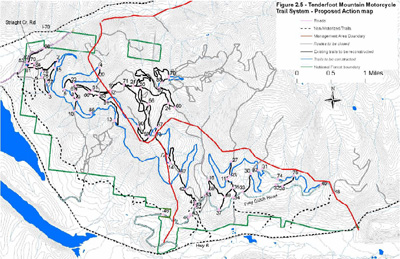 7
7
As a result of the closure of almost all multiple use single track trails on Tenderfoot Mountain, only a small distance of single track multiple use trail remains on the White River National Forest. This recreational opportunity is found in the Golden Horseshoe area of the Dillon Ranger District. The limited numbers of single track trails in the Golden Horseshoe area is reflected by the dotted lines on the MVUM insert for the Golden Horseshoe Area.
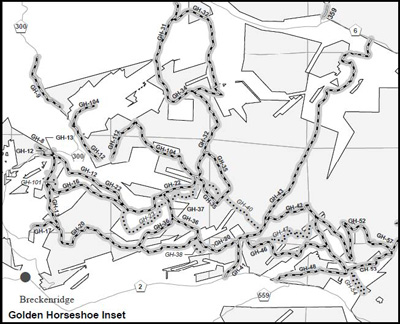
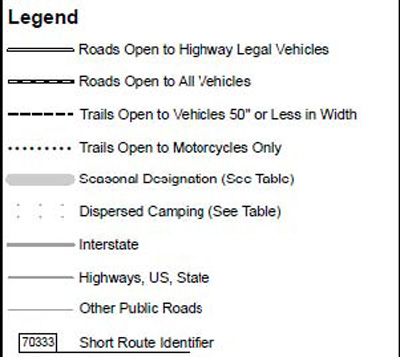 8
8
Given the serious limitation on single track multiple use trails in the Dillon area, this would appear to be a possible violation of multiple use mandates the Forest Service must comply with in managing public lands. The Proposal adds 15 miles of new single track trails and restricts access on trails on the ground to 36 inches max on an additional 15 miles of existing routes over 4,000 acres of planning area. These trails would provide a multiple use single track opportunity that does not alter the significant reduction in the number of routes in the Tenderfoot Mountain area and the White River National Forest as a whole.
3b. Levels of Protection
Much of the correspondence from those opposing the Proposal assert the Proposal allegedly violates Summit County Planning documents. The Organizations must note that while the Summit county regulations certainly must be taken into account in developing the Proposal, these local regulations are an insufficient basis to alter the Federal Statutory requirements for management of public lands, which the Forest Service must comply with. A review of these documents finds many of the standards proposed for management of the Tenderfoot area are wholly inconsistent with Forest Service guidelines and requirements for Travel Management. As a result the Forest Service had to develop a more consistent plan for the management of the Tenderfoot area, that could be effectively implemented.
For several issues, the Proposal provides higher levels of protection than required in the Summit County legislation. The Summit County legislation requires several routes remain open year round for full sized motorized and ATV usage. Based on Wildlife concerns in the Proposal area, Forest Service planners have determined that these routes being open year round would pose a significant threat to elk wintering in the area. As a result of these concerns, seasonal closures of ALL routes is required under the Proposal to mitigate possible impacts to Wildlife. The Organizations have to believe these seasonal closures will be highly effective as routes in the area frequently receive significant snowfall and quickly become impassable to OHVs.
The Organizations must also note the Summit County regulations are often complex and conflicting with general federal road management standards. These conflicts and complexity would result in travel management decisions that are difficult to explain, completely different than forest regulations in other areas, difficult to enforce and would create a significant amount of frustrations and confusion among those that are attempting to use this area. Avoiding this type of user conflicts and frustration will greatly improve public support for management of the area and create a management plan that is sustainable in the long run for this area.
The Organizations vigorously assert that the Proposal provides a far more enforceable plan for the management of the Tenderfoot Mountain area, when compared to other management recommendations for the area.
4. Wildlife Concerns
As previously noted, a seasonal closure of all routes in the Tenderfoot Mountain area from October to June is already part of the Proposal to add an additional level of protection for wildlife possible in the area. The Organizations believe that these seasonal closures will be highly effective given the high levels of snowfall in the area that rapidly make routes impassible to all OHV traffic.
Public concerns voiced by those opposing the Proposal raise concerns about wildlife calving areas being impacted by the Proposal. The Organizations are unsure the basis for these concerns, as CPW mapping does not identify the Proposal area or any portion of the Tenderfoot Mountain area as an Elk Reproductive area. The Elk Reproductive areas identified by CPW are outlined in red on the map below.
Elk Reproductive Areas
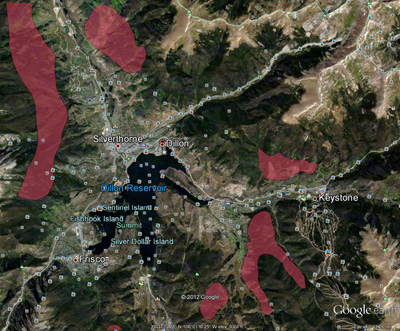 9
9
It appears that those opposed to the Proposal have confused Elk Reproductive Habitat with Elk Winter Range. Elk Winter Range identified by CPW is identified in the areas outlined in purple in the map below.
Elk Winter Range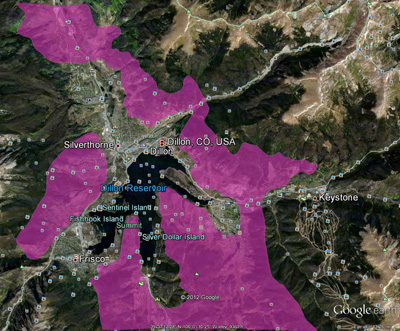 10
10
Given the Proposal already provides all routes in the area be closed from October to June, the Organizations are unsure what basis could be relied on to assert that wintering wildlife in the area would be impacted by the Proposal.
5a. The Proposal does not imcrease sound levels at adjacent propserties.
Sound created by recreational usage of public lands has been a planning consideration in the development of the White River Forests Travel Management Plan. Trails in the Tenderfoot Mountain area, such as the Oro Grande Trail that were closed to motorized travel as they did impact adjacent properties. Under the Proposal, NONE of these trails would be reopened.
Given the awareness of possible sound impacts from the Proposal on adjacent homeowners, professional sound testing engineers have already been brought in to analyze possible impacts on adjacent property from sound. This report does note that the ONLY noise issue that was identified was HWY 6 and the Oro Grande Trail, neither one of which has been addressed in this proposal. A copy of this report is enclosed with these comments.
The report specifically concludes that motorized recreational usage of the trails to be opened in the Proposal does not increase sound levels at these residence beyond ambient levels. This report does note the primary source of sound for these residence was Highway 6. Utilization of highway 6 is beyond the scope of this Proposal.
5b. The Proposal will not threaten wildlife with sound levels.
The possible impact of sound from the Proposal on wildlife has also been a concern voiced in opposition to the Proposal. This type of an impact is an issue that has been extensively researched by the Forest Service. While this research has centered on winter motorized recreation, these findings are completely relevant here as any impacts to wildlife would be more easily recognized during winter periods when stress is greater on the animals. This research has uniformly concluded that sound level related to usage of OHV’s has little to no impact on wildlife. As a result the Forest Service studies have specifically found:
”Based on these population-level results, we suggest that the debate regarding effects of human winter recreation on wildlife in Yellowstone is largely a social issue as opposed to a wildlife management issue. Effects of winter disturbances on ungulates from motorized and non-motorized uses more likely accrue at the individual animal level (e.g., temporary displacements and acute increases in heart rate or energy expenditures) than at the population scale. A general tolerance of wildlife to human activities is suggested because of the association between locations of large wintering ungulate herds and winter recreation. Habituation to human activities likely reduces the chance for chronic stress or abandonment of critical wintering habitats that could have significant effects at the population level, especially when these activities are relatively predictable.”11
This research has also uniformly concluded that animal response to people on foot or with a dog is consistently higher than the animals response to motorized vehicles, even with the higher sound levels that maybe associated with the motorized vehicle.
“Deer consistently bedded near snowmobile trails and fed along them even when those trails were used for snowmobiling several times daily. In addition, fresh deer tracks were repeatedly observed on snowmobile trails shortly after machines had passed by, indicating that deer were not driven from the vicinity of these trails… The reaction of deer to a man walking differed markedly from their reaction to a man on a snowmobile… This decided tendency of deer to run with the approach of a human on foot, in contrast to their tendency to stay in sight when approached by a snowmobiler, suggests that the deer responded to the machine and not to the person riding it.”12
The Organizations believe there is significant research already conducted for the Proposal concluding that sound levels from the Proposal will not impact wildlife. The findings are supported by the extensive body of Forest Service research that has concluded that sound levels from motorized recreation do not have a negative impact on wildlife. Given this body of research, the Organizations do not have any basis to support a concern about sound impacting wildlife in the Proposal area.
Conclusion
The Organizations are aware there is public concern regarding the Proposal. Given that public scoping of the Proposal has only occurred, we believe these concerns are the result of a lack of information regarding the Proposal. The Organizations believe that additional information regarding the Proposal will aid in understanding the specifics of the Proposal and address many of these concerns that may exist as a result of limited information. The Organizations are vigorous supporters of the Proposal as this multiple use trail network will be a significant benefit to recreational users of these trails.
If you would like a copy of any of the reports relied on in these comments or have questions please feel free to contact Scott Jones at 508 Ashford Drive, Longmont CO 80504. His phone is (518)281-5810.
Sincerely,
John Bonngiovanni
Chairman and President
Colorado OHV Coalition
Don.E. Riggle
Director of Operations
Trails Preservation Alliance
Scott Jones, Esq.
COHVCO CO-Chairman
1 Douglas A. McIntyre; American Ghost Towns of the 21st Century; 24/7 Wall Street; April 11, 2011; http://finance.yahoo.com/real-estate/article/112463/american-ghost-towns-21st-century-247wallst
2Humston et al; USFS Office of Rural Development; Jobs, Economic Development and Sustainable Communities
Strategizing Policy Needs and Program Delivery for Rural California; February 2010 at pgs 51-52
3Marshall University Center for Business and Economic Research; Final Report; The Economic Impact of the Hatfield~McCoy Trail System in West Virginia; October 31, 2006 at pg 3.
4Cordell et al; USFS Research Station; Off-Highway Vehicle Recreation in the United States and its Regions and States: A National Report from the National Survey on Recreation and the Environment (NSRE) February, 2008; pg 56.
5Id at pg 56.
6Id at pg 41-43.
7USFS- Dillon Ranger District- Map of Tenderfoot Trail area provided to public with scoping documents on Ocotber 11, 2011.
8USFS – Dillon Ranger District 2012 Motor Vehicle Use Map- Inset of Golden Horseshoe area
9Colorado Parks and Wildlife – 2012 Elk Reproductive areas map in Google Earth formatting provided by Hunting GPS maps
10Colorado Parks and Wildlife – 2012 Elk Winter Range areas map in Google Earth formatting provided by Hunting GPS maps
11PJ White & Troy Davis. Wildlife responses to motorized winter recreation in Yellowstone. USFS 2005 Annual Report at Pg 1.
12Richens, V. B., & Lavigne, G. R. (1978). Response of white-tailed deer to snowmobiles and snowmobile trails in Maine; Canadian Field-Naturalist, 92(4), 334-344.
 Trails Preservation Alliance
All volunteer 501c3 organization, focused on preserving motorized, single-track trail riding.
Trails Preservation Alliance
All volunteer 501c3 organization, focused on preserving motorized, single-track trail riding.
 Trails Preservation Alliance
All volunteer 501c3 organization, focused on preserving motorized, single-track trail riding.
Trails Preservation Alliance
All volunteer 501c3 organization, focused on preserving motorized, single-track trail riding.